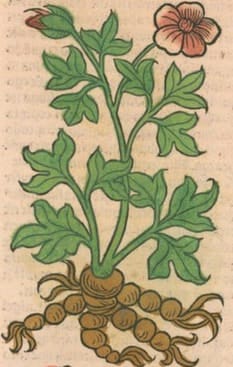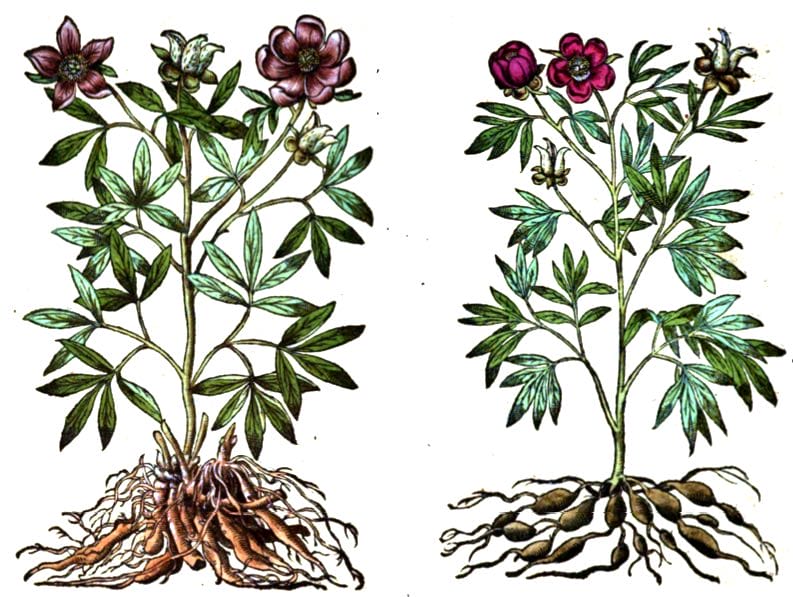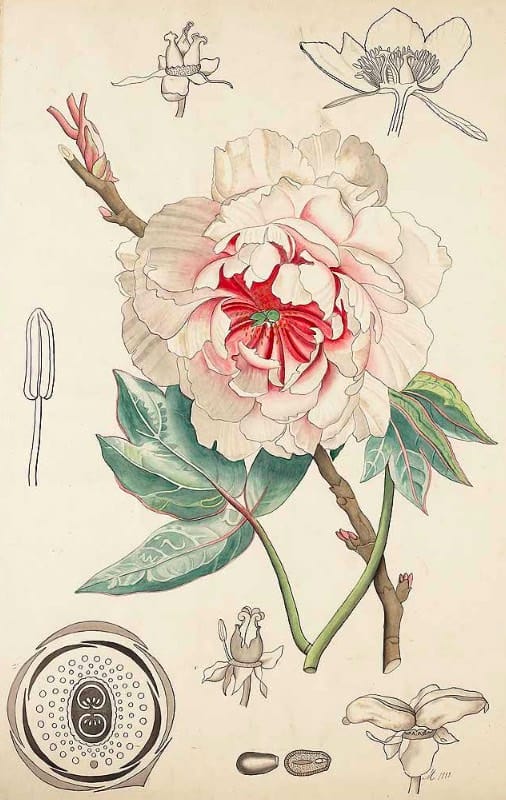Paeoniae, PeonyOod Saleeb, Ood Gharqi (Unani) |

|
 Ortus Sanitatis, Meydenbach, 1491
Ortus Sanitatis, Meydenbach, 1491 Left: Male Peony; Right: Female Peony
Left: Male Peony; Right: Female PeonyKreutterbuch, Matthiolus, 1586
 Botanische wandplaten (1904–1914)
Botanische wandplaten (1904–1914) Members CLICK HERE for the PRO VERSION
Members CLICK HERE for the PRO VERSIONBotanical name:
Paeonia officinalis (‘Female’ Peony)
Others to supply the Peony of the West include P. mascula and P. corallina (‘Male’ Peony), P. parnassica, P. clusii, P. emodii (Himalayan Peony), and the Russian P. anomala.
Parts used:
Root; Flower; Seed was also commonly used in the West
Temperature & Taste:
Neutral (Warm in the West), dry. Sour, slightly Bitter)
Classifications:
2C INCIDERS. 2F. PURIFYING. 2G. CLEANSING. 2I. ANTISPASMODIC. 2K. RESOLVENT
3G. EMMENAGOGUE
4a. CEPHALIC. 4f. SPLENETIC. 4j. NERVINE
Uses:
1. Tonifies the Liver and Blood, Calms the Liver, Stops Wind:
2. Tonifies the Blood, Promotes Menstruation:
3. Opens Obstructions of the Liver:
4. Promotes Urine:
5. Stops Cough and Asthma
Dose:
Seed and Root can be used in similar doses
Powder: 1–3 grams
Decoction: 3–6 grams
Comment:
The European Peony and Chinese White Peony are almost analogous with the European being better to stop Wind and settles Spasms, the Chinese White Peony being more tonifying to the Blood and Yin. The Chinese Red Peony is Colder, less tonifying, and better to move the Blood and clear Heat from the Blood and Liver.
Correctives:
… available in PRO version
Substitute:
… available in PRO version

Main Combinations:
Peony & Licorice
Calamus & Peony
Mistletoe & Peony
1. Peony is very often combined with Mistletoe in the treatment of Wind, spasms, convulsions and nervous diseases.
2. Epilepsy, Convulsions:
i. Peony with … available in PRO version
ii. Peony with … available in PRO version
iii. Peony with … available in PRO version
iv. Peony with … available in PRO version
v. Childhood Epilepsy, Peony … available in PRO version
vi. Childhood Convulsions, Peony with … available in PRO version
3. Epilepsy, Convulsions, Apoplexy, Peony with … available in PRO version
4. Hysteria, Peony … available in PRO version
5. Headache, Peony with … available in PRO version
6. Cold Rheumatic diseases of the Head and Nerves, Peony with … available in PRO version
7. Consumption, Peony with … available in PRO version
Major Formulas
Decoction to Strengthen the Head (Wirtzung)
Cephalic Decoction (Charras)
Electuary of Peony
Electuary Against Sterility (Nicholas)
Electuary of Great Virtue for Vertigo (Hartman)
Electuary of Seseli (Nicholas)
Electuary Against Sterility (Renodeus)
Powder of Mistletoe and Peony (Gabelhover)
Powder for Epilepsy (Quincy)
Tincture for Paralysis
Cautions:
1. Overdose can cause Headache, Tinnitus, Colic and Vomiting.
Main Preparations used:
Distilled Water of the Roots and Flowers, Syrup of the Infusion of the Flowers, Extract of the dried Flowers, Conserve of the Flowers, Salt of the Ashes
-
Extra Info
-
History
|
‘This drug is the Female Peony of Dioscorides, and was esteemed by the ancients as a valuable remedy in uterine obstructions, colic, bilious obstructions, dropsy, epilepsy, convulsions and hysteria. Dioscorides describes two kinds of Peony, male, P. corallina, and female, P. officinalis, these are the two kinds of Fawania described by Arabic and Persian writers. The roots of the first are turnip-shaped and about as thick as the thumb; those of the second consist of oblong tubercles attached by a stout fibre to a rhizome … Ud-salap is used by the natives as a |
blood purifier for children. In the time of Galen a superstition prevailed that Peony root enclosed in a bag and hung round a child’s neck both prevented epileptic attacks and cured them, and this belief is not extinct among the peasantry of Europe even now; they also believe that wearing the seeds will prevent the dangers of dentition. The plant has been proved not to be inert; it produces headache, noise in the ears, confused vision, colic and vomiting if taken in full doses (60grs.) (Vegetable Materia Medica of Western India, Dymock, 1885) |
